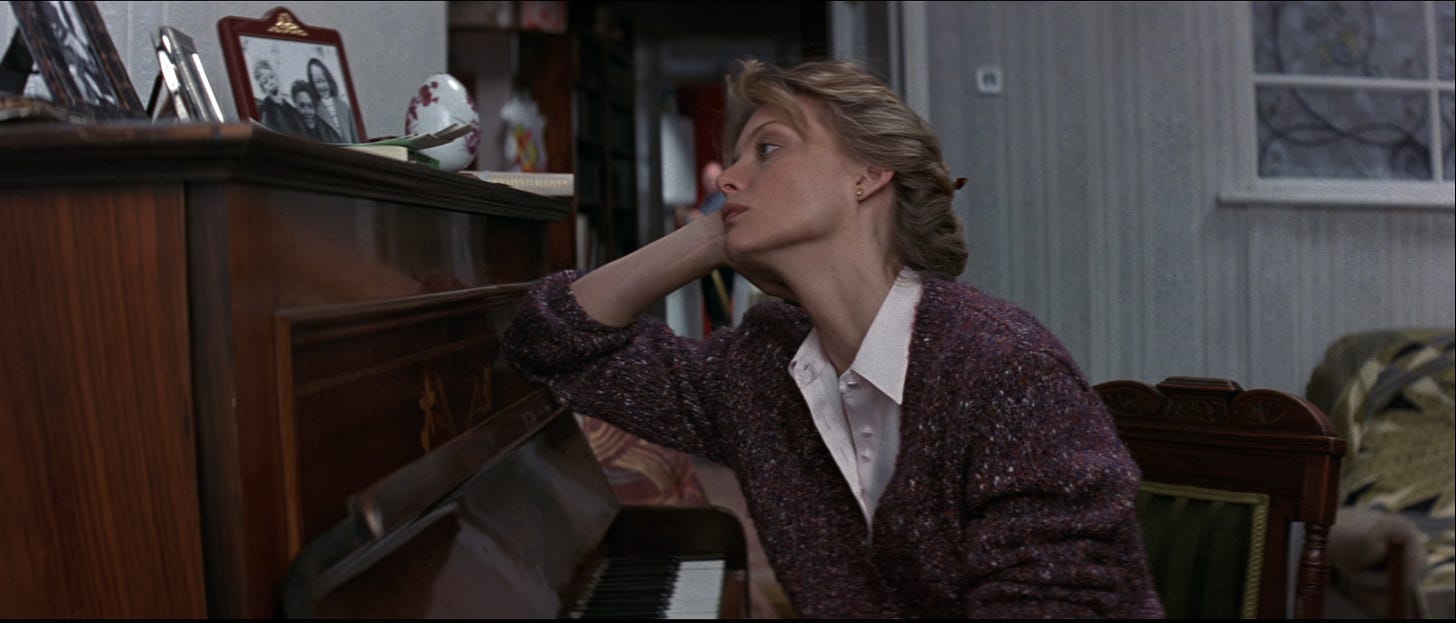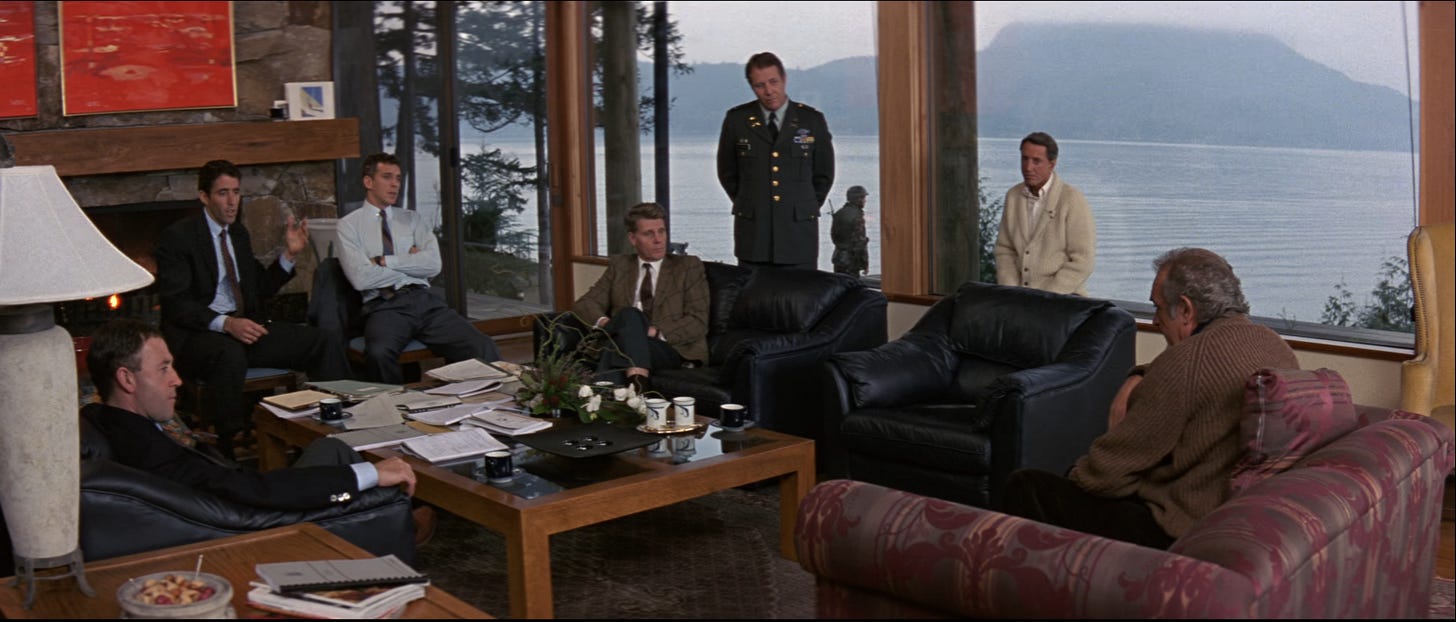Video Days is Mad About Michelle in the month of April, with ten films starring leading lady Michelle Pfeiffer, born April 29, 1958 in Santa Ana, California and celebrating her 67th birthday this month.
THE RUSSIA HOUSE (1990) condenses the novel by John le Carré into a film that’s half-empty and half-full, depending on the thirst of the viewer. The filmmakers force four hours or more of mini-series into two hours of film, keeping their best off the screen for too long in order to get all of the plot in. There are excellent performances by Sean Connery and Michelle Pfeiffer, as well as magnificent locations in what no one knew was the twilight of the Soviet Union.
David Cornwell was recruited by the United Kingdom’s military intelligence, popularly known as MI5, while an undergraduate at Oxford in 1952. He spent five years stationed in Bonn, West Germany. Cornwell left a government service career to write full time, publishing under the pen name “John le Carré.” By the eighties, le Carré was at the top of the bestseller lists with authors like Stephen King and Robert Lundlum. This won him an invitation in May 1987 from the Soviet Union, a country he’d written about but never been allowed to visit. Under the regime of Mikhail Gorbachev, Russia was opening up and allowing freedom of expression as part of its celebrated doctrine of glasnost. Much had changed. The Literaturnaya Gazeta, a weekly cultural newspaper that had labeled le Carré as a provocateur of the Cold War, now welcomed him. On his first visit, le Carré had a vague idea about who the male and female lead characters of his next book would be. On a second visit, in September 1987, he met with Soviet physicist and Nobel Peace Prize winner Andrei Sakharov. They discussed the German physicist Klaus Fuchs, who’d sold the Russians atomic secrets following World War II. Le Carré wondered what would happen if a scientist like Sakharov were motivated to share secrets with the West.
Titled The Russia House, le Carré’s new novel hadn’t even been published when it drew the interest of Fred Schepisi. The Australian filmmaker had directed three critically acclaimed pictures in a row: Plenty (1985) starring Meryl Streep, Roxanne (1987) from a screenplay by and starring Steve Martin, and A Cry in the Dark (1988) with Streep and Sam Neill. Le Carré’s work had attracted some of the most prestigious directors and actors in the film business, Martin Ritt directing an adaptation of The Spy Who Came In From the Cold (1965) with Richard Burton in the lead and George Roy Hill casting Diane Keaton in The Little Drummer Girl (1984). Neither of those were well received, particularly by their author. Hoping The Russia House would break that cycle, le Carré suggested playwright and screenwriter Tom Stoppard write an adaptation. Schepisi, le Carré and Stoppard quickly collaborated on a script (the WGA would award screenplay credit to Tom Stoppard, based on the novel by John le Carré). To produce the picture with him, Schepisi partnered with Paul Maslansky, producer of the Police Academy series.
Maslansky not only spoke Russian, but had made two pictures in the U.S.S.R. He was an executive in charge of production on The Red Tent (1968), an Italian/ Russian co-production starring Sean Connery and Claudia Cardinale. Based on that experience, he was hired to produce The Blue Bird (1976) which featured Jane Fonda and Cicely Tyson, a co-production between the U.S. and Soviet Union that filmed in Moscow and Leningrad. Police Academy and its five sequels had made a lot of money for Alan Ladd Jr., now leading the film division of Pathé Communications when the company acquired MGM/UA and Cannon Films. With Sean Connery on board, Ladd agreed to finance and (through MGM) distribute The Russia House. In May 1989, Maslansky and Schepisi headed to the Soviet Union to negotiate permission to film in Moscow and Leningrad in the fall. Between the state vetting the script for anything they considered pornographic or anti-Communist, and the considerable amount of money Pathe was prepared to spend, the Soviets granted permission.
With a cast filled out by Michelle Pfeiffer, Roy Scheider, James Fox, John Mahoney, J.T. Walsh, and Klaus Maria Brandauer, shooting on a $21 million budgeted version of le Carré’s bestseller commenced in Leningrad (today St. Petersburg) in October 1989. The River Neva (with its Meteor hydrofoil in the background), the Winter Palace, the Summer Garden and Palace Square were featured. Moving to Moscow, Red Square and Manezh Square were utilized, while the town of Peredelkino, where author and poet Boris Pasternak’s grave is located, was used to film the writers’ compound. Maslansky, having learned from his experience keeping cast and crew of The Blue Bird from revolt, had food catered daily from London for one hundred and fifty people. According to the filmmakers, the Muscovites who flocked to the set were less interested in getting a look at Connery as they were in the craft services.
Leaving the U.S.S.R. in early November, production shifted to Portugal, where Connery’s character has a flat in the Lisbon neighborhood of Alfama. Moving on to London, the interiors of Pfeiffer’s character’s apartment were shot at Pinewood Studios. The Pathe offices in London stood in for the interiors of MI5. Finally, in the show’s fourth country, the safehouse where Connery’s character is interrogated by the CIA was filmed in British Columbia on Bowen Island. The Russia House opened in December 1990 amid a calendar crammed with prestige pictures: Awakenings, The Bonfire of the Vanities, Come See the Paradise, The Godfather Part III, Havana. Reviews were mixed. Gene Siskel and Roger Ebert split, with Siskel enjoying the dialogue-heavy plot, which Ebert felt came across like a radio play. The Russia House spent three weeks struggling to remain among the top ten grossing films in the U.S. before disappearing. It received zero Academy Award nominations.
he Russia House concerns a disheveled book publisher, written as if le Carré had golfed with Sean Connery and written the part just for him, the character’s gift of gab well reflected by the Scottish star more so than his drinking habit or messy look, perhaps. When a manuscript addressed to him from a Russian book editor he’s never met (Pfeiffer’s character) is delivered to MI5 by a colleague in Moscow, both the British and American intelligence services press him to make contact with the woman in Russia and get her to identify the source of the nuclear secrets the book contains. With the Soviets opening up and the Cold War thawing (le Carré dated the story in 1987), the Brits and Yanks see this as a ripe opportunity to escalate the spy game. Connery’s character lies to Pfeiffer’s character–a divorced mother of two–about working with anyone else, which he comes to regret once he falls in love with her.
The fact that all this table dressing is necessary to summarize the story, and that half an hour passes before the Connery and Pfeiffer characters meet, is indicative of why the picture–which was remarkably timely, in U.S. theaters a year after the fall of the Berlin Wall and eight months before a failed coup against Gorbachev signaled the collapse of the Soviet Union–was a difficult sell, and remains strenuous to access. The Russia House actually makes a worthy double bill with The Hunt For Red October (1990) for several reasons. Both movies cast Sean Connery and Klaus Maria Brandauer, the latter of whom was set to play Capt. Marko Ramius before dropping out. Playing the physicist willing to betray his country for peace, Brandauer is very charming, his scenes with Connery the best in the film, leaving no doubt he’d have been an excellent Ramius. Both films are based on novels in which East meets West. And rather than winning the cooperation of the U.S. Navy to film their hardware on the high seas, The Russia House won permission to film exteriors in the U.S.S.R. and is almost as impressive.
Crowds and open spaces are pivotal to this spy tale, and shooting in Moscow and Leningrad lends the movie an extraordinary Eastern Bloc look, particularly scenes set in the GUM department store and Kievskaya metro station that could only have been filmed in the Soviet Union. The lighting by Australian cinematographer Ian Baker is striking. By remaining faithful to le Carré’s text, the screenplay is anemic when it comes to suspense, packing up anything that could have qualified as tension and letting it unfold off-screen, while its romance is also dry. Michelle Pfeiffer is well cast–if any one woman could convince men to betray their country, it’s Pfeiffer–but her character isn’t tested or jeopardized enough, nor is Connery’s betrayal one that seems to wound her. Though it would’ve required rewriting le Carré’s stoic book, more passion between the characters and greater stakes would have made for a better movie. That said, The Russia House is overlooked. Jerry Goldsmith, riffing on the jazz music Connery’s soprano sax player belts out, contributes a musical score that is much more zestful than those he’s typically commissioned for.
Video rental category: Drama
Special interest: East Meets West










